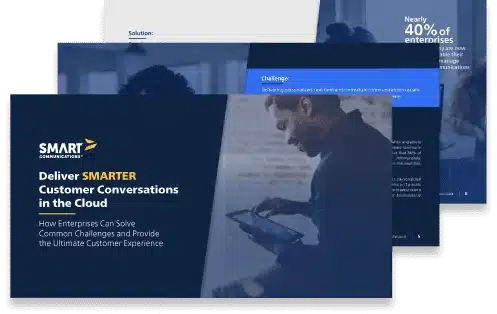Reimagining the Workers’ Compensation Process for Today’s Digital World
By: Ruth Fisk, VP Insurance Strategy at Smart Communications
Most insurance professionals don’t just happen into the industry—they’re here because they want to give back, be part of something bigger and contribute to the greater good. But in an industry that’s been around for centuries, creating real change can be challenging.
When it comes to the workers’ compensation process, change has been especially difficult. Strict regulations, manual efforts and a “we’ve always done it this way” mentality are all barriers. But with the advances in cloud technology, insurers now have the necessary resources at their fingertips to create fundamental change.
With a purpose-built conversational platform, a digital-first workers’ compensation process puts the injured worker at the center of every stage of claims management and makes a positive impact on the people it serves.
The modern workers’ compensation service model is built around empowerment, person centricity and empathy—and it’s driven by long-overdue digital transformation.
Setting the New Standard in the Workers Compensation Process
Communications are at the heart of the claims management process, from the first report of injury (FROI) through settlement and closure. All involved parties have to communicate and collaborate to ensure a swift recovery and speedy return to work. This includes the injured worker, the employer representative, the insurer’s case manager and medical officer, not to mention physicians, physical therapists and other medical providers. And, key documentation must also be communicated to regulatory bodies.
By streamlining communications and making it easy and convenient for the entire ecosystem to exchange information, insurers can empower injured workers and help them achieve the best possible life outcomes. At the same time, increasing efficiency with intelligent automation and systems integration helps to minimize financial implications for both the employer and the insurer.
A cloud-based conversational platform keeps the lines of communication open, while transforming processes with automation, form pre-population and omnichannel access for consistency. The modern workers’ compensation process is all about reducing the hassle factor for everyone involved—bringing the ease and convenience we expect in other areas of our life into a stressful situation, to everyone’s benefit.
A More Complex World Demands Simpler Solutions
Our world is changing faster than ever, and complexity will continue to rise. As jobs evolve, so do hazards and exposures that increase the risk of injury. In fact, according to the International Labour Organization, 270 million accidents and 160 million work-related diseases are reported around the world annually, with more than two million lives lost from workplace accidents. In addition to the human cost, the financial cost of workplace accident, injury and death exceeds $1.25 trillion worldwide.
The good news is, that helping an injured employee return to the workplace even just one day earlier can reduce costs significantly while also – most importantly – improving life outcomes. This makes adopting a modern service model and digitally transforming the claims management process critical for insurers, who share the burden of these costs with employers.
Change the Conversation in Workers’ Compensation
Smart Communications enables the top workers’ compensation insurers to embrace change and engage SMARTER across the entire claims management lifecycle. With the Conversation CloudTM insurers can turn today’s tedious workers’ compensation process into easy, effortless conversations – streamlining and simplifying the experience from start to finish.
Below are how the key capabilities of the Conversation Cloud empower a reimagined workers’ compensation process:
Collect
Accelerate the claims intake process with dynamic digital forms for initial injury reporting, witness statements and material evidence gathering, and add photos easily to enhance the investigation stage. Prepopulating forms with policy information saves time and effort and omnichannel access lets case managers guide stakeholders to the most appropriate channel while maintaining consistency.
Communicate
Automatically generate and share key documentation to maintain compliance with government regulatory bodies. Examples include an FROI acknowledgment letter, occupational safety review reports, accident summary, medical treatment plan, certificate of capacity and return-to-work authorizations. Making communications more dynamic throughout the claims management process helps to keep the injured worker’s recovery on track and optimize outcomes for everyone.
Collaborate
Successful claims resolution requires collaboration between a wide range of individuals. With the Conversation Cloud, insurers can easily connect the case manager to the injured worker, employer, medical officer, physicians and physical therapists, support groups and anyone else with a vested interest in getting the employee back to work quickly.
Coordinate
Easily orchestrate communications between involved parties with a cloud-based platform powering end-to-end claims management workflows. Create a single source of truth to mitigate version control issues, drive faster resolution and support a speedy recovery.
Integration
To further streamline and simplify case manager workloads, the Conversation Cloud integrates seamlessly with core back-end systems such as Guidewire ClaimCenter, Duck Creek Claims and Sapiens ClaimsPro. Automatic updates enable straight-through processing so insurers can easily determine the best next step at any stage.
Intelligence
Engage with all involved parties by infusing intelligence into every conversation. Take advantage of automation to pre-populate forms and ensure compliance. Turn static, one-way interactions into dynamic, two-way experiences. Personalize at scale and maintain the proper tone to help alleviate anxiety and stress.
Transform the Workers’ Compensation Claims Process
Being injured on the job can be stressful on many levels—physically, emotionally and financially. Piling a whole lot of paperwork on top of that certainly doesn’t help. Anything insurers can do to alleviate stress will also help to facilitate recovery, which is the ultimate goal.
With a modern conversational platform at the core of the workers’ compensation service model, insurers can get back to what they care about most: making a difference, giving back and putting people, not process, at the center.
—
To learn more about how Smart Communications supports modernizing the workers’ compensation process, check out The Future of Workers’ Compensation.



